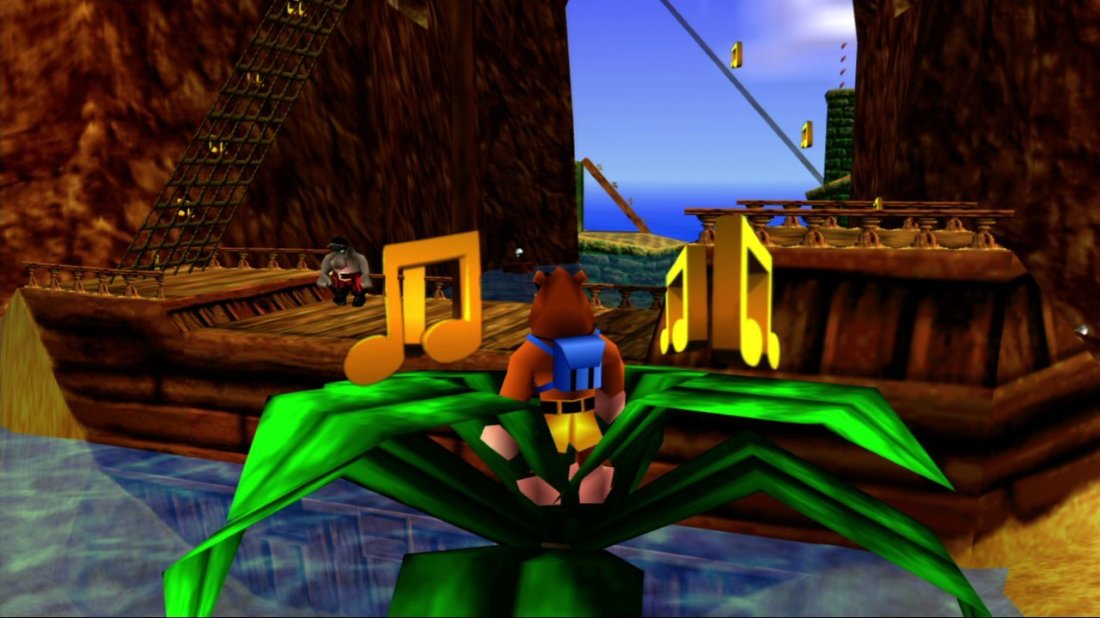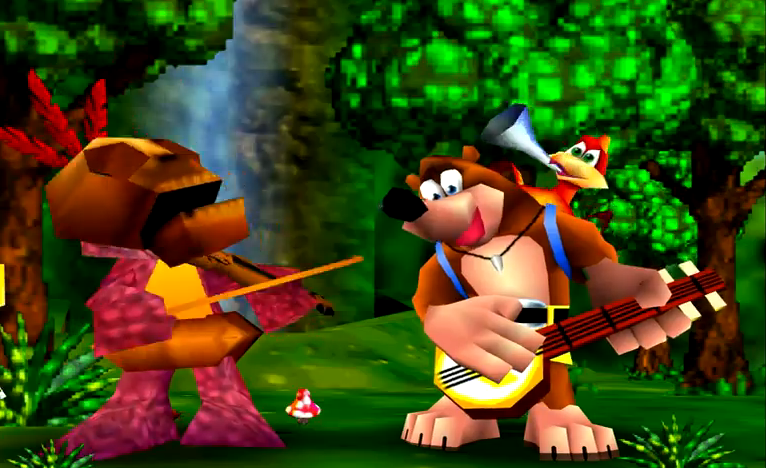A Dream Project Come True
When the Nintendo 64 came out, Super Mario 64 jumpstarted a genre of games known by fans as “3D collectathon platfomers.” They were similar to sidescrolling platformers, except featuring bigger 3D open worlds that players could explore. As the word “collectathon” implies, these games tasked players to amass large amounts of collectibles to progress. UK-based developers at Rare wanted a piece of the action and repurposed one of their unreleased RPG adventure titles, Project Dream, into their own 3D platformer. Following in the footsteps of SM64, they created explorable 3D environments, lovable mascots with an arsenal of moves, and loads of in-game collectibles. Little did Rare’s developers know that they would create one of the most beloved video games of all time and one of the pinnacles of the 3D collectathon platformer: Banjo-Kazooie.
Story
Banjo-Kazooie has a simple story that invokes a fairytale-like charm. The hideous witch Gruntilda wishes to be the most beautiful woman in all the land. Upon learning that a young female bear named Tooty is more beautiful, Gruntilda kidnaps her, planning to sap her looks using a beauty-transfer machine. Enter Tooty’s older brother, Banjo, the kindhearted bear, and Kazooie, the smart-alecky red breegull who resides in Banjo’s backpack. This unlikely duo sets out to rescue Tooty and defeat the evil Gruntilda once and for all. The plot works well to evoke feelings that one might find in a classic Disney fairytale movie and sells the talking animals vs. wicked witch premise effectively.

While the story may sound a bit dry, its execution is anything but. The whole game comes off like a parody of children’s entertainment, told confidently through its cheeky dialogue, self-referential jokes, and instances of hidden adult humor. Even the way characters are presented is untraditional. Banjo is unlike your typical platforming hero and would likely have stayed home if Tooty wasn’t his sister. Kazooie, on the other hand, is outgoing and wisecracking, taking every opportunity possible to insult everyone, including characters who are on their side. Even Gruntilda is silly, communicating exclusively in rhymes and concocting schemes that make little sense, like using a machine to steal beauty and hosting a game show. There are plenty of other likable characters, such as Bottles the nearsighted mole, Gobi the unsuspecting camel, and Mumbo Jumbo the skull-faced shaman. Although all of these characters help you in some form, they usually first engage in witty dialogue filled with quips and sarcasm, mostly thanks to Kazooie’s berating nature.

Gameplay
The goal of Banjo-Kazooie is to explore the different locales of Gruntilda’s castle to collect Jiggies, jigsaw pieces that unlock new worlds. Like in Super Mario 64, the castle acts as a hub world connecting you to 9 diverse themed worlds, such as a beach, swamp, haunted mansion, ship, and desert. While these types are commonplace now, BK was one of the first to showcase these areas in a 3D environment.
Each world is filled with enemies, puzzles, switches, and minigames that you must complete to earn the 10 Jiggies hidden within. Unlike Super Mario 64, Banjo-Kazooie allows you to stay in the world after collecting a Jiggy, fostering an emphasis of exploring and collecting. In a true open-world sense, you are free to achieve these goals in any order within a world. Provided you have learned the necessary moves, you can choose which objective you want to tackle first, or even go back and forth between them. The worlds are like self-contained theme parks with no shortage of attractions. Yet the game guides you to new tasks seamlessly, taunting you with places in the distance and teasing you with collectibles nearby. Even the hub castle has a floor plan filled with secrets and hidden passageways. Rare pulls no punches in the variety of ways you obtain Jiggies. Prepare to go inside a mechanical shark, stomp a camel to force it to unwillingly water plants, get flushed down a toilet, lead a turtle musical choir, and sled onto a polar bear’s stomach to make him cough up a valuable puzzle piece.

Of course, it wouldn’t be a collectathon if Jiggies were the only MacGuffins. There are also honeycombs that refill your health, egg ammunition for shooting, feathers that let you fly, Mumbo tokens that allow you to transform, Jinjos who must be rescued, and Musical Notes. There is plenty to collect, but it never feels overwhelming compared to its sequels and competing 3D platformers. In particular, Musical Notes are the only other collectibles vital to completing the game. There are 100 Notes in each world, and they unlock Note Doors throughout the castle. The primary caveat regarding Notes is that they reset whenever you die or exit the world. Since you need a majority of Notes to beat the game, you will essentially have to stay within a world and collect every Note you can find (ideally all 100). You may be missing a few, not know where they are, accidentally lose a life (which can happen unforgivingly in later worlds), and have to start over. Although this problem is rectified in later installments and remasters, it can be frustrating for those playing the original N64 version.

Banjo and Kazooie have a solid moveset that expands with each level, courtesy of Bottles the move tutor mole. The duo feels very natural to control, and each move is easy to learn. They work well as a team, with Banjo providing the mobility and Kazooie in charge of wing flap jumping, pecking enemies, and shooting eggs. In many ways, Kazooie feels like the true star due to her versatility. Even mobility-wise, she eventually learns how to Talon Trot, walking on her legs at a brisker pace and carrying Banjo for a change. The pair can also fly and swim. When Kazooie takes to the skies, it feels liberating as you explore the heights of what the world has to offer. In contrast, swimming is pretty clunky with Banjo’s slow turn radius and a depleting oxygen bar, preventing this from being a fun experience. Thankfully, there is only one level with a focus on swimming for long periods of time. Finally, the camera is controlled by the C-buttons. Instead of moving gradually, the camera instantly shifts to one of several angles depending on which button you press. Occasionally, the camera will move on its own to present a forced angle. Overall, there aren’t many issues with the camera, albeit being archaic by modern standards.

If it weren’t enough to control a bear with a bird in his backpack, you can also transform into different animals and objects with the aid of the shaman Mumbo Jumbo. By paying him Mumbo tokens, you gain the ability to transform into a termite, crocodile, walrus, and a few other surprises. These transformations keep gameplay fresh, providing a new angle to look at the world and opening up exclusive missions that you can only complete as that morph.

Graphics and Sound
The graphics are vibrant, bright, and colorful. The textures aren’t always smooth, but the cartoonish art more than makes up for it. Every character is designed with personality, and it shows through their animations and idle poses. Worlds are full of detail, with intricate designs of houses, ships, and interiors. There is also a sense of scope, allowing you to see explorable mountains that are far away. As a middle-era Nintendo 64 title, Banjo-Kazooie looks as good as they come.
The music, composed by Grant Kirkhope, is exceptionally pleasing to the ears. Every song is catchy and upbeat, with each one fitting the level’s theme perfectly. Even Gruntilda’s hub castle is a fun inspired rendition of “Teddy Bear Picnic,” with slight variations of the melody based on which world you are near. The jingles that play when you collect each individual item are distinct and recognizable. They’re so memorable that you will likely remember the Jiggy jingle long after you’ve finished the game. Sound effects are spot on and make slapstick cartoonish noises whenever you hit anything. The fact that everyone talks in mumbles and gargles is so lovable and gives each character a unique personality, despite no proper voice acting.

Playtime/Replayability
The game takes roughly 10 hours to beat. It may take a bit longer to get 100% depending on how your perfect Note runs go. Since a regular playthrough basically demands close to 100% completion, you will likely have explored almost everything by the time the credits roll. For Banjo-Kazooie, the replay value is in simply wanting to play it again. It’s fun to just go back, relive the magic, and collect everything. This game is fairly short that speedruns, no-death runs, and completionist playthroughs are easy to justify and fun to boot. For completionists especially, this game is a dream come true with plenty to do and rewards for accomplishing it all.

Conclusion
The 3D collectathon platformer genre has not been explored in recent years, and yet Banjo-Kazooie is so exemplary that revisiting it is nearly enough to whet that appetite. Between the worlds, moveset, and transformations, there is so much variety in the game that it hardly ever feels tedious. Every world is an adventure waiting to happen, sprinkled with missions, minigames, and collectible goodies. There is plenty of personality in the characters and dialogue that contribute to its charm. If you have never played Banjo-Kazooie, it’s worth checking out as it truly is at the peak of 3D platforming.
